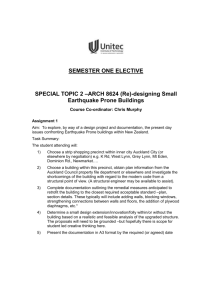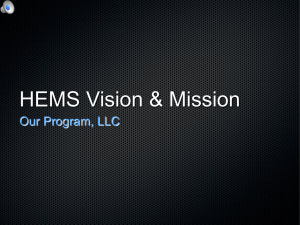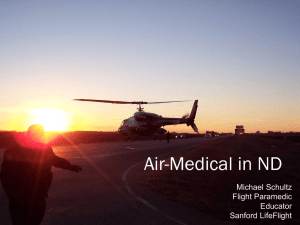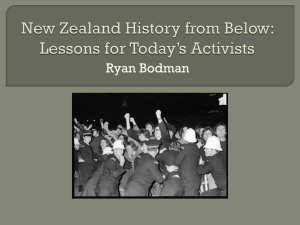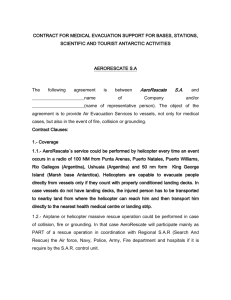Auckland HEMS
advertisement
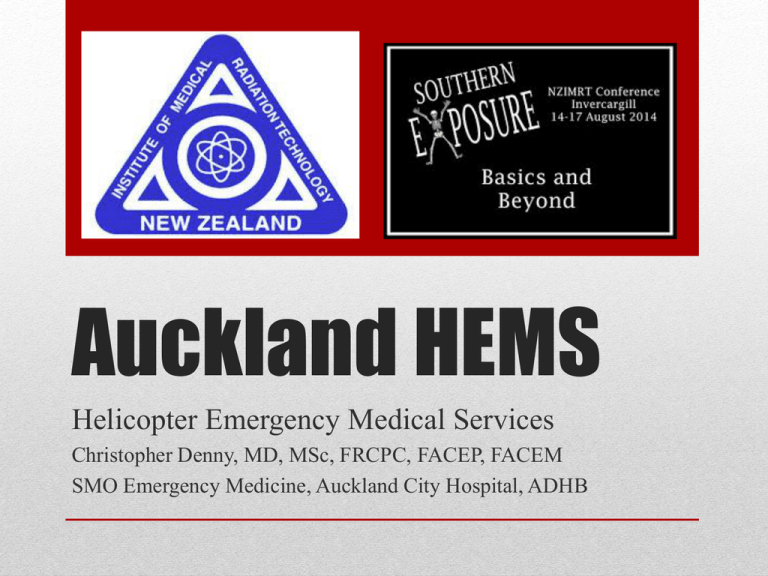
Auckland HEMS Helicopter Emergency Medical Services Christopher Denny, MD, MSc, FRCPC, FACEP, FACEM SMO Emergency Medicine, Auckland City Hospital, ADHB • Senior Medical Officer in Emergency Medicine, Auckland City Hospital • HEMS Medical Director, Auckland Rescue Helicopter Trust (ARHT) • Clinical Team Leader, New Zealand Medical Assistance Team (MOH NZMAT) Disclosure OBJECTIVES 1. 2. 3. Increase awareness of Auckland HEMS Explore Pre-Hospital and Retrieval Medicine Compare patient care on the road with in hospital • 1970: Auckland established the first civilian rescue helicopter service in the southern hemisphere • Rescue helicopter originally based on the west coast of Auckland @ Piha • Now the busiest rescue helicopter trust in New Zealand • The only service in NZ with a doctor as a core member of the flight crew Introduction • Memorandum of Understanding established in 2011 • Specialists in Emergency Medicine, Critical Care and Anaesthetics • Purpose: to augment the clinical capabilities of the flight crew ADHB & ARHT Mission type SAR 1% Interfacility 1% Trauma 43% Medical 55% HEMS Mission profiles • BK-117 x 2 • Cruise speed 120 knots (222km/hr) • Cruise altitude ~1500 feet • Crew configuration: Pilot, crewman, paramedic & doctor • Instrument Flight Rules (IFR) capable • Winch capable • 600lb capacity Helicopters Why doctors? • Airway: Rapid sequence intubation (RSI), video laryngoscopy (VL), surgical airway • Breathing: Mechanical ventilation, chest drains • Circulation: Tranexamic acid (TXA), Point-of-care ultrasound (POCUS), blood products • Disability: Reduction of dislocations and fractures; ultrasound-guided regional nerve blocks, field amputations, antidote therapies Critical interventions • Time to critical intervention: • • • • Airway management CT Operating theatre Interventional radiology Accelerating time to definitive care Clinical governance • Galvagno. JAMA 2012: HEMS and Survival after Major Trauma. • 223,475 patients in USA with age >15y & ISS>15 • HEMS Odds Ratio for survival 1.16, 95%CI 1.14-1.17 (ARR 1.5%) Evidence • From roadside to bedside in definitive care • Standardized communications (METHANE, MIST, SBAR) Seamless care • Coordinated Incident Management System (CIMS) • Inter-agency collaboration with St John Ambulance, NZ Fire Services, Police SAR • Aeromedical reconnaissance Disaster preparedness • “To turn a team of experts into an expert team.” • Eduardo Salas High performing teams • High task interdependency • Cooperation, coordination, communication, cognition, coaching and conflict Teamwork • Integration • Coordination • Clinical networks The future Thank you. www.aucklandhems.com


